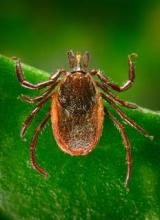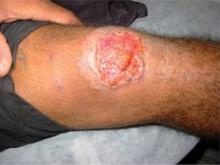LAS VEGAS - Some of the effects of climate change are beginning to appear in dermatologists' offices, and there may be more to come.
Expanded geographic ranges of tick and parasite vectors due to climate change already are pushing infectious diseases into unfamiliar territory, Dr. Sigfrid A. Muller said at a dermatology seminar sponsored by Skin Disease Education Foundation (SDEF).
Lyme disease has spread well into Canada, and leishmaniasis is moving north from Mexico into Texas, Arizona, Oklahoma, and Ohio. Reports of Chagas disease are increasing in the United States and Central and South America. Peru and Ecuador are seeing more Carrion’s disease, he said.
Extreme heat, drought, and wide-scale fires, storms, and flooding, as well as other manifestations of climate change, will alter the incidence and severity of allergies, atopic dermatitis, and asthma, added Dr. Muller, a dermatologist in Las Vegas and chair of the International Society of Dermatology's Climate Change Task Force. The society, in 2009, declared climate change to be the defining dermatologic issue of the 21st century.
Global warming may be debated in the popular media, but there is little controversy about it in the scientific literature, he said. June 2010 was the warmest month on record (combining global land and ocean average surface temperatures) and the 304th consecutive month with a global temperature above the 20th-century average, according to the National Oceanic and Atmospheric Administration.
Scientists predict changes already underway will warm the planet at least 2 or 3 degrees Centigrade this century, and perhaps double or triple that if humans don't alter the behaviors that contribute to climate change. Current scientific estimates suggest that an increase of 2 degrees Centigrade may be the "tipping point" that triggers irreversible changes (such as methane release from melting permafrost) with unpredictable but severe consequences for the planet and its inhabitants, Dr. Muller said.
Some projected changes already are being seen in the extreme summer heat in western Russia, flooding in Pakistan, intense wildfires in Australia, and drought in regions of the United States and elsewhere. The patterns of resulting changes in some skin diseases from these conditions will vary regionally depending on altitude, latitude, storms, deforestation, desertification, urbanization, land use patterns, energy production, and transportation.
Dr. Muller highlighted changes in several diseases:
• Lyme disease. Lyme disease used to be limited to five U.S. geographic regions, but its geographic range has expanded into many areas of Canada as temperatures have become more hospitable to the rodents and deer that act as vectors and reservoirs, spreading into southern and northern Ontario, southern Québec, Manitoba, the Prairie Provinces, the Maritime Provinces, and British Columbia.
• Leishmaniasis. This vector-borne parasitic disease is endemic in most tropical regions of the world and has begun to expand northward as more habitats become suitable for the rodents and sand flies that act as vectors and reservoirs for Leishmaniasis. The parasite has been isolated from humans, dogs, rodents, and sand flies in Texas, Arizona, Oklahoma, and Ohio. Climate change will exacerbate this spread, especially into the east-central United States, Dr. Muller predicted.
• Chagas' disease. The protozoan that causes Chagas disease Trypanosoma cruzi is becoming more common in U.S. wildlife reservoirs, with prevalences increasing by 37% in opossums, by 47% in southeastern U.S. raccoons, and by 29% in Louisiana armadillos, he said. It is expected to spread into central U.S. regions if average temperatures rise by 1 degree Centigrade by 2030, as predicted. Few states require reporting of Chagas' disease, but the Food and Drug Administration in 2010 approved screening for the disease in blood, tissue, and organ donors.
• Carrion's disease. Children bear the brunt of this reemerging disease that has spread to new areas between the jungle and highlands of Peru and Ecuador. Changes in sea surface temperatures that triggered extreme seasonal rain patterns known as El Niño events in the 1980s and 1990s were associated with a nearly fourfold increase in Carrion's disease in Peru's Ancash region.
Dr. Muller urged dermatologists to join the International Society of Dermatology and attend its climate change conferences. Scientific, political, and public strategies are needed to help reduce human contributions to climate change and to plan adaptations to reduce damage caused by global warming, he said.




